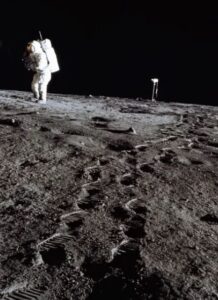
It’s not too early to start thinking about the archaeology of the Moon, contends space archaeologist Alice Gorman in an interview in The New Lean.
The Apollo 12 mission in 1969 marked the first encounter with an archaeological artifact on the Moon. Astronauts landed 180 meters away from Surveyor 3, a robotic landing craft sent to the Moon in 1967. they removed a camera and other bits and pieces to take back to Earth, When NASA analyzed the materials, they found that the Surveyor 3 and Apollo 12 landings stirred up enough lunar dust to abrade the surfaces.
Future missions are planning to visit the Apollo sites and remove samples for analysis to gauge the impact on the lunar environment on human materials. What concerns Gorman is the prospect of erasing all those original footprints and causing further damage by stirring up more dust.
There is an archaeological principle that you never excavate all of a site. You always leave an unexcavated deposit, or you leave rock art on the walls. You leave material for future scientists to sample because we don’t know what techniques will be available in the future.
If we look at this from an archaeological perspective first of all, we ought to be sitting down and thinking: OK, what materials do we really need to collect? We’ve got the baseline from Surveyor 3 – what are the best materials to compare to that?
Gorman expects to see lunar tourism, although some of it may be virtual — “[involving] us projecting into robots and going for little jaunts across the lunar surface.”
More than 500 people have been to space, but only a handful to the Moon. In the foreseeable future, the number of people who have been to the Moon and back will number in the hundreds. Says Gorman:
We might get sick of hearing people tell their stories about the work they did on the Moon. Maybe this will be commonplace. The Moon will just be like thinking about Antarctica. It’s remote, but still part of our world.
I tend to disagree. The potential for visiting historical sites such as the Apollo land zones, climbing Everest-size mountains, and descending into lava holes — all the while experiencing the novel sensation of low gravity — will drive a massive tourist industry. But that gets us back to Gorman’s original point: How do tourists visit the original Apollo landing sites without destroying what they came to see? Is anyone besides Goram thinking that far ahead?
